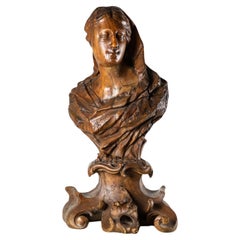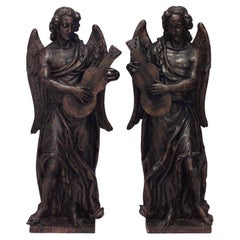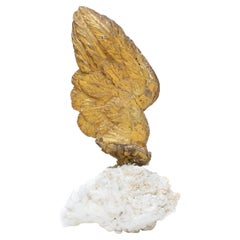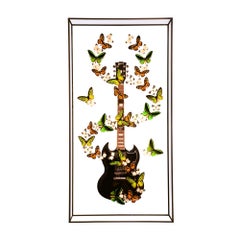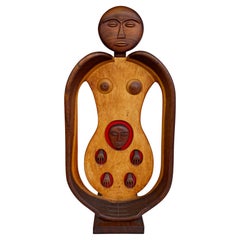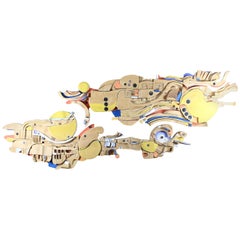Wood Figurative Sculptures
to
564
2,495
270
99
610
487
1,398
369
280
571
290
28
25
35
58
34
87
100
121
46
17
317
200
165
109
101
70
50
49
37
22
22
18
16
10
10
6
4
2
7,105
4,454
3,889
3,494
2,864
1,488
1,219
1,495
563
400
352
322
Height
to
Width
to
2,864
2,641
2,748
63
56
18
13
8
Material: Wood
FRENCH SCULPTOR 17TH CENTURY, Sculpture "Saint Mary Magdalene"
Located in Madrid, ES
FRENCH SCULPTOR 17TH CENTURY,
Sculpture "Saint Mary Magdalene"
Sculpture from the Louis XIV era in carved wood with a contemporary base
45 x 35 ...
Category
17th Century French Louis XIV Antique Wood Figurative Sculptures
Materials
Wood
$7,208 Sale Price
20% Off
19th Century Pair of Italian Renaissance Revival Oak Angel Statues
Located in Queens, NY
Pair of Italian Renaissance style (19th Century) carved oak large angels with guitars.
Category
19th Century Renaissance Antique Wood Figurative Sculptures
Materials
Wood, Oak, Walnut
18th Century Italian Angel Wing with Rutilated Quartz on an Aragonite Base
By Interi
Located in Dublin, Dalkey
18th century Italian gold leaf angel wing with rutilated quartz crystals on natural-forming aragonite crystal cluster. The hand-carved angel wing was once part of a heavenly, angelic depiction in a historic church in Italy.
The aragonite is from Morocco and is known for this particular type of crystalized formations. The mineral emulates a cloud which is compliments the 18th century Italian gilded angel wing. The rutile quartz crystals are adorned on the base and aspects of the wing and the gold of the rutile perfectly matches the original gilded 18th century Italian artifact...
Category
18th Century Italian Rococo Antique Wood Figurative Sculptures
Materials
Quartz, Rock Crystal, Gold Leaf
Butterflies AC DC Guitar
Located in Paris, FR
Guitar Butterflies AC DC made of a real Gibson SG black guitar
staging with real butterflies from farms, cites are provided for the
butterflies. Art work und...
Category
21st Century and Contemporary French Wood Figurative Sculptures
Materials
Glass, Wood
$27,512
1970s Edwin Scheier Carved Sculpture Symbolizing Fertility
By Edwin Scheier
Located in Miami, FL
1970s Edwin Scheier Carved sculpture Symbolizing Fertility
Offered for sale is a rare, untitled sculpture of Guanacaste wood and paint by the listed A...
Category
Late 20th Century American Wood Figurative Sculptures
Materials
Hardwood, Paint
$2,650 Sale Price
30% Off
Bertil Vallien Unique and Monumental Wall Sculpture in Glass and Wood, 1966
Located in Skanninge, SE
A very important early work by Bertil Vallien b. 1938.
Unique and monumental wall sculpture, hand painted and contour sawn wood.
Made in Sweden 1966. One of a kind!
The sculpture is depicting fishes in the water. It was commissioned by an optician in 1966.
That is why the eyes are made of oval glass mirrors. They are also hiding the holes where
you screw the sculpture to the wall.
The sculpture would be great in a fish restaurant or in an indoor pool area.
It will certainly make a statement wherever it will hang!
A photograph depicting the artist in front of the sculpture is included (see image)!
Fully signed and dated 1966 (see image).
The sculpture is in 3 parts. The upper part is in one piece. The lower part is in 2 pieces.
There are no problems hanging this on the wall. It is heavy but not that heavy.
Measurements:
The upper part, Lenght 226cm, height 68cm, 7cm deep.
The lower part, Lenght 245cm, height 75cm, 7cm deep.
As mounted as in the pictures: length 304cm, height 120cm.
Total length if one put these pieces after one another, circa 475cm.
You can put this sculpture on the wall with different combinations and variations.
In 2017 Flint Institute of Arts in Michigan bought the "One million Dollar Boat".
They paid one million dollars for the mixed media sculpture "Passage" made by Bertil Vallien.
BERTIL VALLIEN
EDUCATION AND PROFESSIONAL EXPERIENCES
1963 - ongoing Freelance designer for Kosta Boda glassworks, Sweden
1963 - ongoing Independent artist/designer
1961-63 Studies in USA and Mexico
1961 University of Art and Design, Stockholm, Sweden
PUBLIC COLLECTIONS (SELECTION)
Victoria and Albert Museum, London, England
Metropolitan Museum of Art, NY, USA
HM de Young Museum, San Francisco, USA
Yokohama Art Museum. San Francisco, USA
Imagine Museum, FL, USA
The State Hermitage museum, St. Petersburg, Russia
Düsseldorf Museum of Fine Arts, Düsseldorf, Germany
Museum of Arts and Design, NY, USA
The Art Institute, Chicago, USA
National Museum, Stockholm, Sweden
VIDA Museum, Sweden, permanent wing
Everson Museum, NY, USA
Museum of Fine Art, Boston, USA
National Museum of Art, Tokyo, Japan
Microsoft Art Collection, Seattle, Wa, USA
JB Speed Art Museum, Louisville, USA
The Prescott Collection at Pacific First Centre, Seattle, USA
Detroit Art Institute, Detroit Il, USA
Yokohama Art Museum, Yokohama, Japan
The Powerhouse Museum, Sydney, Australia
Museum für Kunst und Gewerbe, Hamburg, Germany
Mint Museum of Art and Design, Charlotte, NC, USA
Dayton Art Institute, Dayton, Ohio, USA
Museo del Vidrio, Monterrey, Mexico
Musée des Art and Design, The Louvre, Paris, France
The Montreal Museum of Fine Arts, Montreal, Canada
Rockford Museum of Art, Rockford, IL, USA
Microsoft Art Collection, Seattle, USA
National Museum, Edinburgh, UK
Flint Institute of Art, Flint, MI, USA
AWARDS (SELECTED)
Prince Eugen´s medal for outstanding achievement in art, conferred by the King of Sweden (1998)
Gold medal, Royal Academy of Science, Stockholm, Sweden (2005)
GAS Visionary Award (2020)
Honorary doctorate, Växjö University, Sweden (2002)
Artist of the future Award, Imagine Museum, FL, USA (2020)
Visionaries Award, Museum of Arts and Design, NY, USA (2001)
Medal for exhibition “Nine Rooms” at the 13th Biennale in Venice given by Instituto Veneto di Scienze ed Arti (2012)
Young American award, Museum of Arts and Design, NY, USA (1961)
Award in recognition of the promotion of Glass Art in the world, Museo del Vidrio Monterey, Mexico (2004)
The Libensky Award, Seattle, WA, USA (2008)
The Wilson Award, GAS, New Orleans, USA (2005)
Urban Glass Award for >>Outstanding Achievement in Glass<< NY, USA (1998)
Zweiter Coburger Glaspreis, Coburg, Germany (1985)
BIBLIOGRAPHY (SELECTION)
2020 Ytspänning, Galleri Glas, Stockholm, Sweden
2020 Drawings, Ceramics, Glass, Staffan Bengtsson, Kosta förlag, Sweden
2012 Bertil Vallien, Nine Rooms, Publisher Marsilio, Italy
2008 Staven, Gunnar Lindqvist, Kamras/ Kamras förlag
2007 Transperent Bounaries, Ulla-Britt Edberg, Carlsson Bokförlag, Stockholm
2006 Vallien, Gunnar Lindquist, Carlsson Bokförlag, Stockholm
2002 Somna Vakna, Matthew Kangas, University of Washington Press, London
2002 Fiat Lux, Johan Unger Gunnar Lindquist, Carlsson Bokförlag
1998 Glass eats light, Gunnar Lindquist, Carlsson Bokförlag
1997 Headbook, Niclas Rådström, Publisher, Kamras/Kamras
1995 Anod, Peter Nilsson, Nordstedts förlag, Sweden
1990 Bertil Vallien, Gunnar Lindqvist, Carlson Bokförlag
1983 Sandcast, Ulf Thomas Moberg, Moberg Publisher
EXHIBITIONS (SELECTION)
2020 Ytspänning, Galleri Glas, Stockholm, Sweden
2020 Vida Museum, Öland, Sweden
2019 Habatat gallery, Detroit, USA
2019 Schantz Gallery, Stockbridge-MA, USA
2018 Leger Gallery, Malmö, Sweden
2017 Gallery Schantz, Stockbridge, MA, USA
2017 Art Miami, Schantz gallery, Miami FL, USA
2017 Spritmuseet, Stockholm, Sweden
2016 Hawk Gallery, Columbus. OH, USA.
2016 Galleri Thomassen, Göteborg, Sweden
2016 Millesgården, Stockholm, Glasstress, Sweden
2016 Edsvik Konsthall, Edsvik, Sweden
2016 SOFA, Navy pier Chicago IL- USA
2015 Galleri Berengo, Muranoi, Italien
2014 Palazzo Guinigi, Lucca, Italien
2013 Gallerie Azur, Spa, Belgien
2011 Marina Barovier Galleria, Venedig, Italien
2011 Hawk Galleries, Columbus, OH, USA
2009 Imago Gallery, Palm Springs. CA. USA
2008 Etienne gallery.Oisterwijk, The Netherlands
2007 Heller Gallery, NYC, USA
2007 Rockford Art Museum, Rockford, Il, USA
2006 Prince Eugen´s Waldermarsudde, Stockholm, Sweden
2005 Landkrona Konsthall, Landskrona, Sweden
2005 Röhsska Museet, Gothenburg, Sweden
2004 Museo del Vidrio, Monterrey, Mexico
2003 Rockford Art Museum, IL, USA
2003 Glass Museum, International Centre for Contemporary Art, Tacoma, USA
2002 Cellier de Clairvaux, Dijon, France
2002 >>In Transit<< Gävle Museum
2002 Eremitaget, St. Petersburg, Ryssland
2002 The state Hermitage Museum, St. Petersburg, Russia
2002 Konstindustrimuseet, Oslo, Norway
2001 Riihiimäki Museum, Finland
2000 Traver gallery, Seattle, WA, USA
1999 Museum of Contemporary Art, Warsaw, Poland
1999 Eretz Israel Museum, Tel Aviv, Israel
1998 Traver Gallery, Seattle, WA, USA
1998 The Bullseye Gallery Portland, OR, USA
1998 Museum of History, Stockholm, Sweden
1997 Museum of Arts, Indianapolis, USA
1997 Museum of Arts and Design, NY, USA
1969 Palazzo Ducale, Venice, Italy
PERFORMANCE
2012,18,19, 20 Rainshower, Kosta glassworks, Sweden
2007 Diamonds and Ashes, Music: Tomidas, Midnight session at Åfors glass...
Category
1960s Swedish Scandinavian Modern Vintage Wood Figurative Sculptures
Materials
Glass, Wood
Striking Gilded Standing Thai Buddha Sculpture
Located in Hopewell, NJ
Classic Thai gilded wood standing Buddha in a serene pose, mounted on newer ebonized wood stand.
Category
1960s Thai Vintage Wood Figurative Sculptures
Materials
Wood
Italian sculptor of the 17th century, pair of candlesticks
Located in Milano, IT
Italian sculptor of the 17th century,
pair of candlesticks ...
Category
Early 17th Century Italian Antique Wood Figurative Sculptures
Materials
Wood
Abstract Wooden Grey-White Sculpture “Free to Turn" by Christofer Kochs 2016
Located in Salzburg, AT
Contemporary abstract wooden sculpture “Free to Turn", made by using circular saws, painted light grey
on a white background. Signed Christofer Kochs, 2015
The figure depicts a gir...
Category
2010s German Modern Wood Figurative Sculptures
Materials
Wood, Paint
Salvador Dali Contemporary Portlligat Wood Sculpture Sunbed
Located in Barcelona, Barcelona
Design by Salvador Dalí, 1903
Manufactured by BD Barcelona
Solid Iroko wooden structure with polyamide wheels. Optional upholstered cushion with water repellent foam and materia...
Category
2010s Spanish Modern Wood Figurative Sculptures
Materials
Wood
Whimsical Original Pottery Sculpture by David Gil of Bennington Artware Studio
By David Gil
Located in Hopewell, NJ
Distinctive David Gil whimsical ceramic face sculpture that conjures “Picasso”, using negative space imaginatively. Mounted on custom painted wood stand.
Category
1970s American Mid-Century Modern Vintage Wood Figurative Sculptures
Materials
Pottery, Wood
Studio Craft Wilted Flower Fantastical Sculpture after Wendell Castle
Located in Virginia Beach, VA
A whimsical wilted flower with an ostrich foot base all out of stack laminated and carved cherry. The bottom of the sculpture with a heavy stippled finish that fades to a sanded smoo...
Category
1960s American Mid-Century Modern Vintage Wood Figurative Sculptures
Materials
Cherry
Mid 20th Century Vintage Boho Plaster Torso of Man
Located in West Palm Beach, FL
Elevate your interior with this striking vintage plaster torso sculpture, a testament to classic artistry and bohemian flair. Crafted with remarkable detail, this piece captures the ...
Category
Mid-20th Century American Mid-Century Modern Wood Figurative Sculptures
Materials
Plaster, Wood
$760 Sale Price
20% Off
Chinese Hand Carved Dragons Sculptures - a Pair
Located in Delray Beach, FL
Experience the cultural richness of Chinese mythology with this pair of Hand-Carved Dragon Sculptures. Each piece is a work of art, featuring intricate details and dynamic poses that...
Category
Mid-20th Century Chinese Wood Figurative Sculptures
Materials
Wood
Yoruba Painted Veranda Post
Located in Chicago, IL
Hand carved with a figurative design, this TOTEM-like wooden post was crafted by an artisan of the Yoruba peoples of Nigeria. Resembling the tall houseposts used to support the roof of a home, this shorter post would have been placed on a veranda courtyard as a symbolic and decorative element and did not bear weight. This veranda post...
Category
Mid-20th Century Nigerian Tribal Wood Figurative Sculptures
Materials
Wood
Our Lady with Child Jesus Savior of the World 17th Century
Located in Madrid, ES
Our lady with child Jesus savior of the world 17th century
Portuguese sculpture
in polychrome and gilded wood.
Repaints.
Height: 71 cm
very g...
Category
Early 17th Century Portuguese Renaissance Antique Wood Figurative Sculptures
Materials
Wood
1950s Carved Wood Sculpture of Mans Head
Located in Tarrytown, NY
1950s Carved wood sculpture o a man’s head. Signed by artist.
Category
1950s Vintage Wood Figurative Sculptures
Materials
Wood
Large French Bronze Spelter Figure of an Artist, After Mathurin Moreau
Located in Austin, TX
A large French sculptural figure of an artist or painter from the Louis XV period, mounted to a circular moulded base of faux marble painted wood.
One of a pair of bronzed and pat...
Category
Late 19th Century French Antique Wood Figurative Sculptures
Materials
Metal, Bronze, Spelter
Hagenauer Bronze & Wood Sculpture Dancer Wiener Werkstatte, Josephine Baker
Located in Buenos Aires, Olivos
Hagenauer Bronze & Wooden Dress Sculpture Dancer Wiener Werkstatte, Josephine Baker.
Very rare Art Deco 1920´s Josephine Baker dancer sculpture. Silvered bronze and black polished wo...
Category
Early 20th Century Austrian Art Deco Wood Figurative Sculptures
Materials
Bronze
Figurative Transavanguardist Sculpture, Naples, Italy, 1990s
Located in Naples, IT
Transavantgarde portrait in copper, wax and acrylic, wooden base, Naples 1990
Category
1990s Italian Mid-Century Modern Wood Figurative Sculptures
Materials
Copper
Large Holy Land Mother-of-pearl, Abalone Shell and Olive Wood Icon
Located in London, GB
A large Holy Land mother-of-pearl, abalone shell and olive wood icon
Jerusalem, early 20th century
Icon: height 55.5cm, width 52cm, depth 18cm
Case: height 15.5cm, width 61.5cm, depth 57.5cm
In fitted case, presented by the President of the Senate...
Category
Early 20th Century Israeli Modern Wood Figurative Sculptures
Materials
Abalone, Mother-of-Pearl, Olive
Old family tree of the Makonde tribe, Tanzania, 1960s
Located in Ciudad Autónoma Buenos Aires, AR
Old family tree of the Makonde tribe, Tanzania, 1960s
An ancient sculpture called “Family Tree” hand carved by an artist from the Makonde tribe living in Tanzania. The sculpture is m...
Category
Late 20th Century African Tribal Wood Figurative Sculptures
Materials
Wood
$960 Sale Price
20% Off
Framed Collection of Mesoamerican Pre-Classic Period Sculptures & Arrow Heads
Located in New York, NY
Incredible collection of pre-columbian clay sculptures / figures / statues / pottery, mounted and framed. The pieces date from the pre-classic (Formative) period of Meso-American cul...
Category
15th Century and Earlier North American Pre-Columbian Antique Wood Figurative Sculptures
Materials
Hardwood, Precious Stone, Clay
Ashanti Maternal Fertility Figure
Located in Atlanta, GA
On offer is an Ashanti female fertility figure from Ghana, West Africa, circa Mid-20th century. Carved from a single block of wood, the statue depicts a female with typical coiffure ...
Category
Mid-20th Century Ghanaian Tribal Wood Figurative Sculptures
Materials
Glass, Wood
$2,000 Sale Price
33% Off
John W. Mills (1933-2023) ’Single Entry’ Diver Sculpture
Located in Wormelow, Herefordshire
An unusual patinated resin sculpture titled ’Single Entry’ by the acclaimed British sculptor, John W. Mills.
Part of the divers in motion series, this maquette is mounted on an inte...
Category
21st Century and Contemporary English Mid-Century Modern Wood Figurative Sculptures
Materials
Resin, Wood
Large Antique Figurative Sculptural Lamp by Grégoire
Located in London, GB
Large antique figurative sculptural lamp by Grégoire
French, Late 19th Century
Lamp: Height 129cm, width 42cm, depth 40cm
Base: Height 76cm, width 43cm, depth 43cm
Overall: Height 20...
Category
Late 19th Century French Neoclassical Antique Wood Figurative Sculptures
Materials
Marble, Bronze
'Hell Souvenir' figures By Jake and Dinos Chapman, 2022
Located in London, GB
For sale, Jake and Dinos Chapman's 'Hell Souvenir', a grotesque selection of 1:35 scale figures from the artist's purgatorial dioramas 'Hell', 'F*cking Hell', 'End of Fun' and 'The S...
Category
2010s British Wood Figurative Sculptures
Materials
Metal
Mid-Century Articulated Metal and Foam Mannequin Lay Figures
Located in London, GB
A set of seven highly unusual lay figure mannequins.
Metal, foam and plaster.
Various figures which articulate.
The figures seem to be...
Category
Mid-20th Century French Wood Figurative Sculptures
Materials
Wood
1960s Hand Carved Wood Sculpture Of Man Praying / Weeping
Located in Tarrytown, NY
1960s Large Hand-Carved Wood Sculpture of Man Praying / Weeping Buddha
Abstract Yoga
Wrestler
There is a story about two warriors associated w...
Category
1960s Unknown Vintage Wood Figurative Sculptures
Materials
Wood, Teak
Early 19th Century Bronze Mounted Figure
Located in Hudson, NY
Early 19th century mounted bronze 3/4 profile. Likely French but possibly English. Carved wooden backing custom just for this particular item. In the original frame and retaining an ...
Category
Early 19th Century French Grand Tour Antique Wood Figurative Sculptures
Materials
Bronze
Large Pair of Patinated and Gilt Bronze Atlas Figures
Located in London, GB
Large pair of patinated and gilt bronze Atlas figures
French, 20th century
Figure with globe: Height 135cm, diameter 46cm
Figure with armillary sphere:...
Category
20th Century French Neoclassical Wood Figurative Sculptures
Materials
Bronze
20th Century Chinese Cork Diorama, 1950s
Located in LEGNY, FR
Beautiful 20th century rectangular Chinese Cork diorama.
Finely carved decoration in its glass case and black lacquered base.
Careful and delicate work ...
Category
1950s Chinese Vintage Wood Figurative Sculptures
Materials
Cork
$249 Sale Price
20% Off
Brutalist Steel Sculpture of “Amphetrite” by Dale Edwards
By Dale Edwards
Located in Palm Springs, CA
Welded steel sculpture of “Amphetrite” goddess of the ocean. By American sculptor Dale Edwards.
Signed Dale and dated 74 (see detail photos).
In origi...
Category
1970s American Brutalist Vintage Wood Figurative Sculptures
Materials
Steel
Art Deco Masterpiece Sculpture by René Buthaud
By René Buthaud
Located in Zurich, CH
This article features a striking statue by René Buthaud, a prominent French sculptor known for his mastery of form and material. Signed and measuring 70 cm in length, this piece exem...
Category
1930s French Art Deco Vintage Wood Figurative Sculptures
Materials
Metal
Unusual Pair Teki Modern Lounge Chairs by William Westenhaver for Witco
Located in Buffalo, NY
Unusual pair oversized, Teki Modern lounge chairs by William Westenhaver for Witco, definitely over the top, same chairs can be seen in Elvis Presley's Graceland. Crazy carved walnut...
Category
1960s American Mid-Century Modern Vintage Wood Figurative Sculptures
Materials
Fabric, Walnut
Christ - Umbria, second half of the 15th century
Located in Bruxelles, BE
Christ
Umbria, Orvieto?
Second half of the 15th century
77 x 16.5 cm
Category
15th Century and Earlier Italian Renaissance Antique Wood Figurative Sculptures
Materials
Walnut
Mid Century Modern Wooden Bird in Flight Sculpture
Located in Seattle, WA
Believed to be MCM style Myrtlewood Oregon Wooden Seagull with Swivel Base but cannot confirm. This piece has nice patina and character. Vintage conditi...
Category
1970s Mid-Century Modern Vintage Wood Figurative Sculptures
Materials
Wood
19th Century Austrian Carved Pine Folk Art Farmer and His Oxen Model
Located in London, GB
19th century carved pine folk art farmer and his oxen model
We are proud to offer a unique example of a late 19th century hand carved pine folk art model of a farmer and his oxen. R...
Category
Early 1900s Austrian Folk Art Antique Wood Figurative Sculptures
Materials
Pine
Vintage Metal and Wooden Statue of a Naked Woman, Signed
Located in Milano, IT
Beautiful painted metal statue designed and made by Rosario in the 1980s, fine Italian manufacture. Signed.
The statue has a very elegant black wooden base with grass-like grain. On...
Category
1970s Italian Mid-Century Modern Vintage Wood Figurative Sculptures
Materials
Metal
$1,153 Sale Price
20% Off
Mid Century Sculpture See Saw Signed Manuel Felguérez 1960s
Located in San Juan Capistrano, CA
An incredible mid-century modern sculpture by listed Mexican artist Manuel Felguérez depicting two children on a seesaw. The sculpture, depicting a boy and girl on a seesaw, or teete...
Category
1960s Mexican Mid-Century Modern Vintage Wood Figurative Sculptures
Materials
Metal
18th Century Italian Hand-Carved Angel Wing on Honey Calcite Crystal
By Interi
Located in Dublin, Dalkey
18th century Italian hand-carved and painted angel wing with baroque pearls and mounted on honey calcite crystal.
The hand-carved angel wing was once part of a heavenly, angelic de...
Category
18th Century Italian Rococo Antique Wood Figurative Sculptures
Materials
Rock Crystal, Gold Leaf
Louis Giraud Nude Ceramic Sculpture Vallauris 1940s
Located in Antwerp, BE
Louis Giraud to Vallauris France sculpture
' Swimmer ' in grey ceramic original base in wallnut signed Giraud Vallauris
20th century circa 1940
Dimensions
62 cm x 28cm x 18 cm
Category
Mid-20th Century French Hollywood Regency Wood Figurative Sculptures
Materials
Ceramic, Wood
$2,144 Sale Price
30% Off
Mandacaru Series, Wooden Cactus Tall Floor Sculpture
Located in Santa Edwiges, MG
SCULPTURE SERIES MANDACARU
“Mandacaru
When it burns in the drought
It is the sign that the rain arrives in the sertão”
Luiz Gonzaga.
Cordel poems dry on the clotheslines, and throu...
Category
2010s Brazilian Minimalist Wood Figurative Sculptures
Materials
Wood
$6,000 / item
Large Cross with Christ from the 18th Century
Located in Madrid, ES
Large cross with christ from the 18th century. The cross is decorated with tortoise shell, ivory and ebony. The christ is sculpted in high quality ...
Category
18th Century Italian Baroque Antique Wood Figurative Sculptures
Materials
Wood
"Child Jesus", Wood, Spanish School, 17th Century, pedestal made later.
Located in Madrid, ES
"Child Jesus". Carved and polychrome wood. Spanish school, 17th century. Base or pedestal made later.
Christ is presented naked, with a slight contrapposto on the legs and hips that...
Category
17th Century Spanish Baroque Antique Wood Figurative Sculptures
Materials
Other
Mickey Mouse Vintage Wood Sculpture
Located in Palm Beach, FL
Whimsical Mickey Mouse wood sculpture hand carved and painted in his blue tuxedo.
Category
Mid-20th Century American Mid-Century Modern Wood Figurative Sculptures
Materials
Hardwood
Mid-Century Oak Nude Torso
Located in Queens, NY
American Mid-century modern (1950s) limed oak stylized carved nude female torso mounted on an ebonized square base
Category
Mid-20th Century American Mid-Century Modern Wood Figurative Sculptures
Materials
Oak
Corpus Wood Polychrome Antique Christi 18th Century Sculpture Image 33cm
Located in Poperinge, BE
Beautiful antique wooden Corpus Christi (body of Christ) statue, sculpture, from around the beginning of the 18th century probably Flemish
Beautiful wood carving and polychrome (pai...
Category
Late 18th Century Belgian Antique Wood Figurative Sculptures
Materials
Gesso, Fruitwood
Late 19th Century Live Size Renaissance Revival Italian Figural Carved Sculpture
Located in Chicago, IL
This late 19th-century carved wooden sculpture is a lifesize depiction of a young nobleman of the Italian Renaissance. The piece is made entirely from wood and carved gesso under an ebonized finish, giving it the illusion of an oxidized bronze sculpture. The young man is posed in a classic Contrapposto stance, which is an Italian term that means "counterpoise". This term usually refers to a standing human figure carrying its weight on one leg so that the opposite hip rises to produce a relaxed curve in the body, a dynamic pose that is most associated with Renaissance art. He establishes his stance with a hand on his large belt and one hand in the air holding a torch. This Renaissance revival piece is highly detailed through intricate workmanship, down to the Lion of Saint Mark...
Category
Late 19th Century Italian Renaissance Revival Antique Wood Figurative Sculptures
Materials
Plaster, Wood
Finely Carved Wood Thermometer Stand Hunter and Staghound, 1910
Located in Berghuelen, DE
Finely Carved Wood Thermometer Stand Hunter and Staghound, 1910
A Black Forest thermometer with impressive carved hunter and staghound standi...
Category
Early 20th Century Austrian Black Forest Wood Figurative Sculptures
Materials
Wood
Early Adjustable Industrial Machinist Stool, Manufactured by Toledo
Located in Buffalo, NY
Early adjustable Industrial machinist stool, manufactured by Toledo,, Wonderful original patina color and surface. Solid carved wood top and back.
Category
1920s American Industrial Vintage Wood Figurative Sculptures
Materials
Metal
Pair, Victorian Period Hand Forged Suit of Armor Knight Figures, Articulating
Located in Atlanta, GA
Great victorian models with partial moving hands and arms. Hand crafted figures of great quality and mounted to wood bases.
Category
Late 19th Century British Victorian Antique Wood Figurative Sculptures
Materials
Iron
$1,200 Sale Price / set
20% Off
15th Century Spanish Gothic Virgin and Child Polychrome Wooden Sculpture
Located in Marbella, ES
15th century Spanish Gothic Virgin and child polychrome figurative wooden sculpture.
Category
15th Century and Earlier Antique Wood Figurative Sculptures
Materials
Wood
A 17th Century Mounted French Limestone Carving of a Winged Angel
Located in Dallas, TX
Originally part of a larger architectural from a French building in the 1600s, this hand-carved limestone fragment of a winged angel has been mounted more recently to a painted black...
Category
17th Century French Baroque Antique Wood Figurative Sculptures
Materials
Stone, Limestone, Metal
"Artist's Model, " Rare and Important WPA Era Sculpture of Male Nude
By Raymond Turner
Located in Philadelphia, PA
Beautifully sculpted from a ruddy block of mahogany and finished with a patina that gives it a lovely glow, this piece is a superb example of WPA-era sculpture. The artist, Raymond T...
Category
1930s American Art Deco Vintage Wood Figurative Sculptures
Materials
Mahogany
Set of 4 Victorian Pine Draped Female Figures
Located in Queens, NY
Set of 4 French Victorian pine figures of classically draped females on scroll carved base (late 19th Cent)
Category
19th Century Victorian Antique Wood Figurative Sculptures
Materials
Pine
$90,000 / set
Museum Quality French White Marble Roundel Relief of Emperor Napoleon III, 1860
Located in Queens, NY
A museum quality French white marble roundel relief of Emperor Napoleon III, circa 1860.
The quality of this marble sculpture of Napoleon III is trul...
Category
19th Century French Napoleon III Antique Wood Figurative Sculptures
Materials
Marble
$40,000 Sale Price
20% Off
Antique Circus Clown with Poseable Arms and Caracterful Smile
Located in Leuven , BE
An intriguing example of a fully articulated circus puppet marionette, in the form of a clown. This figure is fully articulated with iron strings support...
Category
20th Century French Wood Figurative Sculptures
Materials
Wood
Wooden Sculptures Book End Set Of 3 Thinking Decorative Figurine of Book Holders
Located in Wembley, GB
Book Ends Wooden style acrylic Sculptures A Set Of 3 Decorative Figurines of Human Book Holders + Thinking Man Sculpture.
Beautifully stylized a set of figurines...
Category
1990s Turkish Art Deco Wood Figurative Sculptures
Materials
Acrylic, Wood, Fruitwood, Driftwood, Pine, Bog Wood
$412 Sale Price / set
35% Off
Ethnodesign Katoyo Mask representing the "Foreigner" with headdress from Angola.
Located in Leuven , BE
This unusual Chokwe mask is probably Katoyo, representing non-Chokwe individuals. The deviation of the mask from the more common Chokwe masks is mainly because they represent Portugu...
Category
Early 20th Century Angolan Wood Figurative Sculptures
Materials
Wood, Fabric
Recently Viewed
View AllMore Ways To Browse
Bronze Horse And Chariot
Bronze Judith
Carl Kauba Bronze
Depose Bronze
Antique Royal Dux
Art Deco Stone Statue
Berrocal Puzzle
Bronze Head Of Zeus
Bronze Warrior Head
Capodimonte Figurine
Cold Painted Bronze Girl
Antique German Bisque
Antique Passport
Antique Passports
Architectural Salvage Cast Iron
Art Nouveau Black Statue
Berrocal Puzzle Sculpture
Ceramic Woman Sitting
